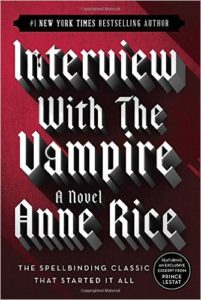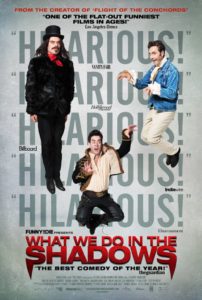Since launch, Speculative Chic has featured articles on personal writing journeys, collections of things people love, and some amazing reviews. So why are we suddenly throwing an academic discussion on vampires at you? Because I’m a huge nerd, that’s why! (See my bio page for official details and credentials regarding my nerdiness.) By now you’ve gotten a taste of me through my contributions to the My Favorite Things and Sound Off! features, so you know I’m into SF/F in all mediums (books, film, television, and games). Though my personal blog is where you’ll find things like my book reviews, content related to my fiction, and other personal life updates, here at Spec Chic I’d like to share posts on topics that relate to my passions in a more broader sense. For example, the article below was written as a way to distill a bit of the research on vampires I’ve done over the years in an effort to continuously define the way I write about them myself. Please enjoy, and I hope you’ll share in the comments a bit about your favorite examples of the lovable — and not so lovable — undead.
This post originally appeared on SF Signal on October 30, 2015.
Vampires drink blood and/or kill people to survive. So why have they endured in the imagination of popular culture for almost two hundred years? Because it turns out that while vampires are monsters of death along with the rest of the villains of the horror genre, they are also a lot about sex. And if there’s one thing that modern culture likes to be entertained by, it’s sex.
The historical influences of vampires were terrifying. Vlad the Impaler’s reputation of excessive cruelty, including impaling his enemies on giant stakes, spread throughout Europe. His female counterpart, Countess Elizabeth Báthory, was a serial killer accused of murdering young female virgins and bathing in their blood to retain her youth. Neither of these things is terribly sexy.
Yet two centuries later, we find ourselves with Edward Cullen from Stephenie Meyer’s Twilight series, written for the young adult paranormal romance subgenre, in which a handsome vampire seduces a modern teenage girl. How did we get from bathing in blood to sparkling in the sunlight?
 The modern era of vampire myth in Western literature began in 1819 with the publication of “The Vampyre,” a short story by John Polidori that is often viewed as the origin of the romantic vampire genre in fantastical fiction. Polidori imbued his Lord Ruthven with seductive elements despite the fact that everyone the character encountered ended up suffering. Not all authors treated vampires as creatures of sexuality, however. In James Malcolm Rymer’s serialized gothic horror (1845–47), Sir Francis Varney the vampire is presented as the first sympathetic vampire, who despises his condition but is still a slave to it. Both of these works establish many of the tropes that become the staples of vampire lore in years to come, such as fangs and puncture wounds to the neck.
The modern era of vampire myth in Western literature began in 1819 with the publication of “The Vampyre,” a short story by John Polidori that is often viewed as the origin of the romantic vampire genre in fantastical fiction. Polidori imbued his Lord Ruthven with seductive elements despite the fact that everyone the character encountered ended up suffering. Not all authors treated vampires as creatures of sexuality, however. In James Malcolm Rymer’s serialized gothic horror (1845–47), Sir Francis Varney the vampire is presented as the first sympathetic vampire, who despises his condition but is still a slave to it. Both of these works establish many of the tropes that become the staples of vampire lore in years to come, such as fangs and puncture wounds to the neck.
In the Victorian and Puritan ideals of Europe and North America, vampirism in literature became a surrogate for sexual intercourse. Later in the 19th century, sex returns with a vengeance in Joseph Sheridan LeFanu’s Carmilla (1871) and Bram Stoker’s Dracula (1897), the latter of which brought vampires into the cultural mainstream. Though Stoker was inspired by the historical Vlad the Impaler, his Dracula was a veritable rake who manipulated women to his own ends. Due to cultural sensibilities that precluded sexual encounters between characters, Stoker used vampirism as a cover for the sexuality inherent in his horror novel. As originally created by Stoker, the persona of Dracula contains an amalgam of cultural sexual dreads such as foreignness, animalism, and dreamlike qualities. The vampire became an extended metaphor; just as death has been used as a euphemism for orgasm, the vampire represents both sexuality and death.
 And thus was born the sexy vampire trope. Vampires represent the titillating anxieties we carry that a sexual act will carry grave punishment such as death. Though the vampire remained firmly in the traditional horror genre for many years, providing readers with such classics as Stephen King’s Salem’s Lot (1975), it never quite forgot its subversive sexual roots. When Anne Rice published Interview with the Vampire, the first novel in her Vampire Chronicles series, in 1976, she brought the world the lives of Louis and Lestat and solidified the link between vampires and sex in mainstream horror and fantasy.
And thus was born the sexy vampire trope. Vampires represent the titillating anxieties we carry that a sexual act will carry grave punishment such as death. Though the vampire remained firmly in the traditional horror genre for many years, providing readers with such classics as Stephen King’s Salem’s Lot (1975), it never quite forgot its subversive sexual roots. When Anne Rice published Interview with the Vampire, the first novel in her Vampire Chronicles series, in 1976, she brought the world the lives of Louis and Lestat and solidified the link between vampires and sex in mainstream horror and fantasy.
Changing social mores allowed greater aspects of sexuality to be directly portrayed in works of popular fiction. By the early 1990s, adult readers were devouring the more explicit escapades of the characters in Laurell K. Hamilton’s Anita Blake: Vampire Hunter series (Guilty Pleasures, the title of the first book in 1993, says it all). Sex and drama have always been intertwined, and young adult readers were introduced to J.L. Smith’s The Vampire Diaries series in 1991 (currently the most popular television show on the CW network).
Not all vampires of the 21st century are sexy. Sunglasses After Dark, written by Nancy A. Collins in 2005, features Sonja Blue, a vampire character less interested in sex and more focused on killing other monsters like herself. Vampires are also alive and well in historical horror, such as Kate Cary’s Bloodline (2006), in which a soldier in World War I interacts with a vicious descendant of Stoker’s Dracula and Mina Harker. In urban fantasy, such as Jim Butcher’s The Dresden Files and my own Steel Victory, vampires are written more along the philosophy of “vampires are people, too”: perhaps older but not necessarily wiser.
These days, paranormal romance is where vampires really shine (and sometimes sparkle), exploding this subgenre and upstaging the werewolves and other mythical creatures. The vampires there are people too, just older and much, much more attractive. A cable network like HBO was necessary to bring Charlaine Harris’ Southern Vampire Mysteries to the screen to handle the sexual content, and Richelle Mead’s Vampire Academy series for young adults has even spawned a secondary series, Bloodlines. The astounding popularity of the Twilight series, despite any criticism of plot and characterization, secured a lot of expectation that stories about vampires must also include elements of romance if not outright eroticism.
 Original vampire television shows such as Forever Knight, Buffy the Vampire Slayer (and its spinoff Angel), and Moonlight adapted a lot of this sexual expectation, combining the concept of the sympathetic vampire (tragic heroes) with the romantic love interest. Original films featuring vampires as both heroes and villains have run the gamut from traditional terrifying horror (Nosferatu, 1922, and From Dusk Till Dawn, 1996) to ridiculous comedy (Blacula, 1972, and What We Do In the Shadows, 2014). Comics and graphic novels have remained the haven of the tales of the vampire hunters (Blade and Nightstalkers) and dark vampiric heroes who are not necessarily also romantic characters (League of Extraordinary Gentlemen and American Vampire).
Original vampire television shows such as Forever Knight, Buffy the Vampire Slayer (and its spinoff Angel), and Moonlight adapted a lot of this sexual expectation, combining the concept of the sympathetic vampire (tragic heroes) with the romantic love interest. Original films featuring vampires as both heroes and villains have run the gamut from traditional terrifying horror (Nosferatu, 1922, and From Dusk Till Dawn, 1996) to ridiculous comedy (Blacula, 1972, and What We Do In the Shadows, 2014). Comics and graphic novels have remained the haven of the tales of the vampire hunters (Blade and Nightstalkers) and dark vampiric heroes who are not necessarily also romantic characters (League of Extraordinary Gentlemen and American Vampire).
Authors and creators will continue to reinvent the vampire to appeal to changing times and cultures, but the vampire seems to have found a solid niche in fiction as the representation of sex and its relationship with death. That focus has shifted much of the balance to sex over death, but it’s quite possible that the pendulum will swing back over time.

I think the romance angle is interesting especially. Romance separated from the sex, I mean. Because yeah, sex and feeding and blood all sort of go together in the deeply physical sense. But I feel like romances are flailing, looking for that Mr. Perfect for their heroes and well, the old standbys don’t work so well any longer. We know too much; we’re too connected to reality. Powerful CEOs? Less sexy than they used to be when you’ve got Trump and Martin Shkreli on the scene. The “exotic” other? Well, Sheikhs and princes and all those are kind of hard to come by. Cowboys? Not so much with big agribusiness. But Vampires…. they’ve lived a long time and had all sorts of adventures; they’re rich, of course they’re rich, because hey, they don’t spend money on food, and when you live forever, your stock portfolio can have time to grow and grow; and they’re just that little bit dangerous in a way that we can swallow. A “bad boy” hero who is human? Makes me think of restraining orders, not romance.
In a way we can swallow? I see what you did there! Seriously, though, that is a great perspective. Restraining orders versus romance, indeed.